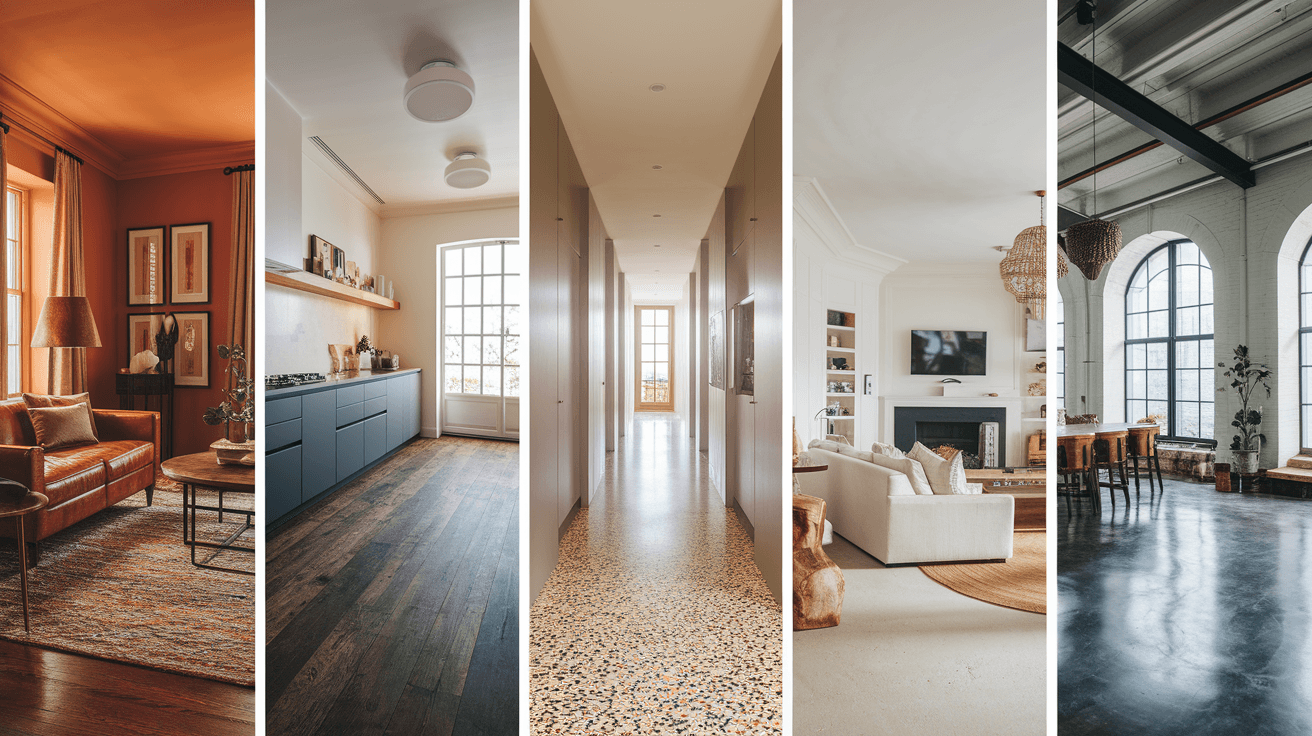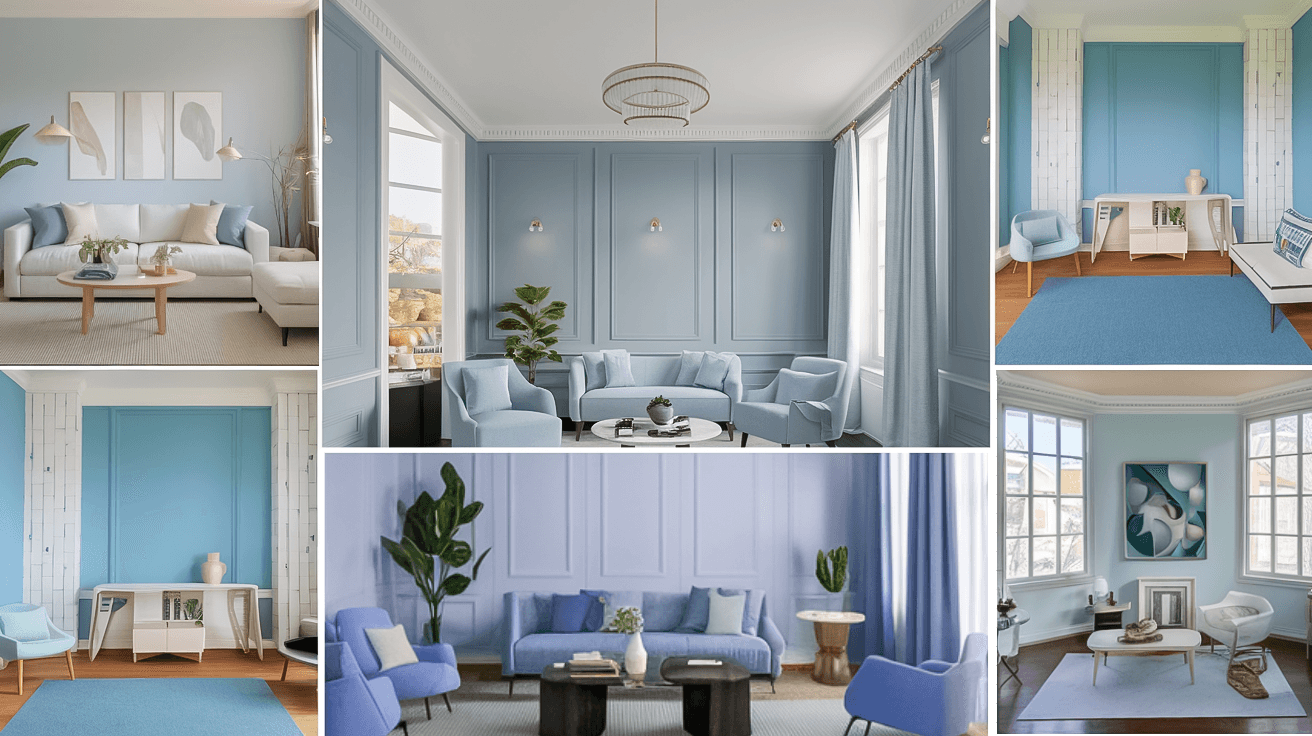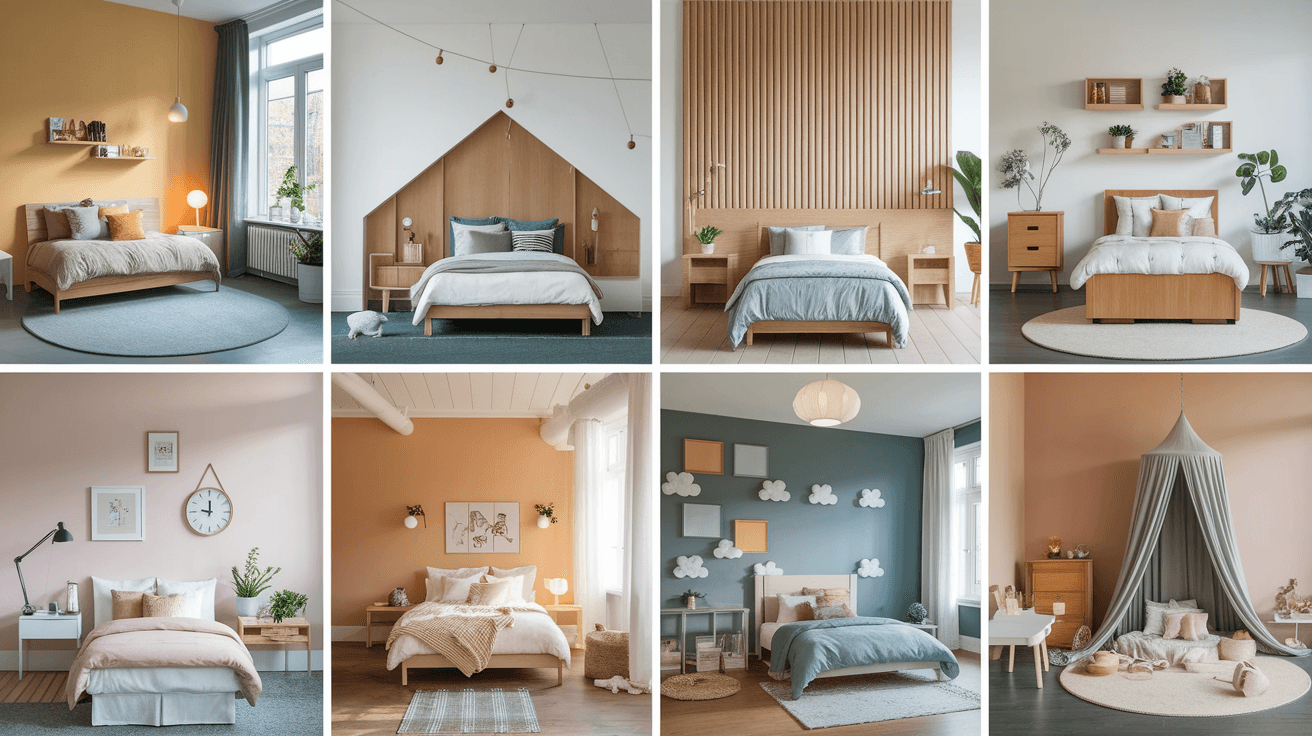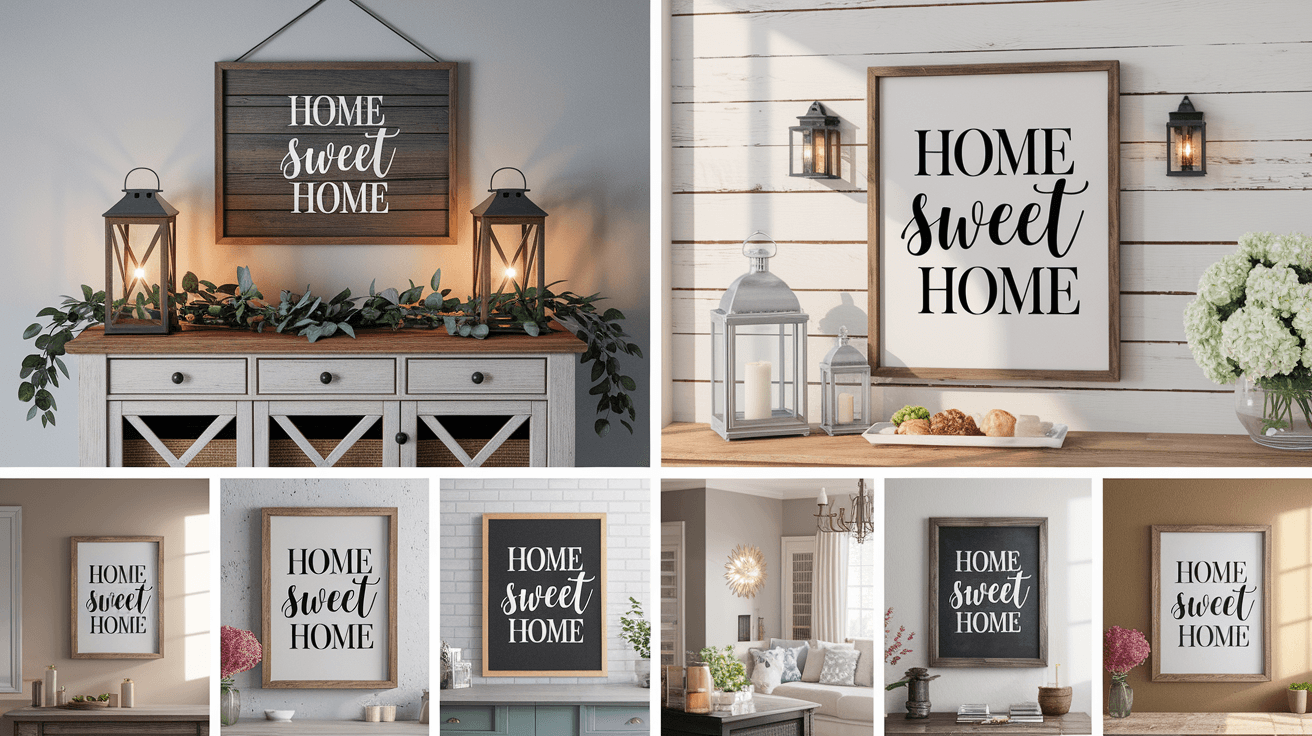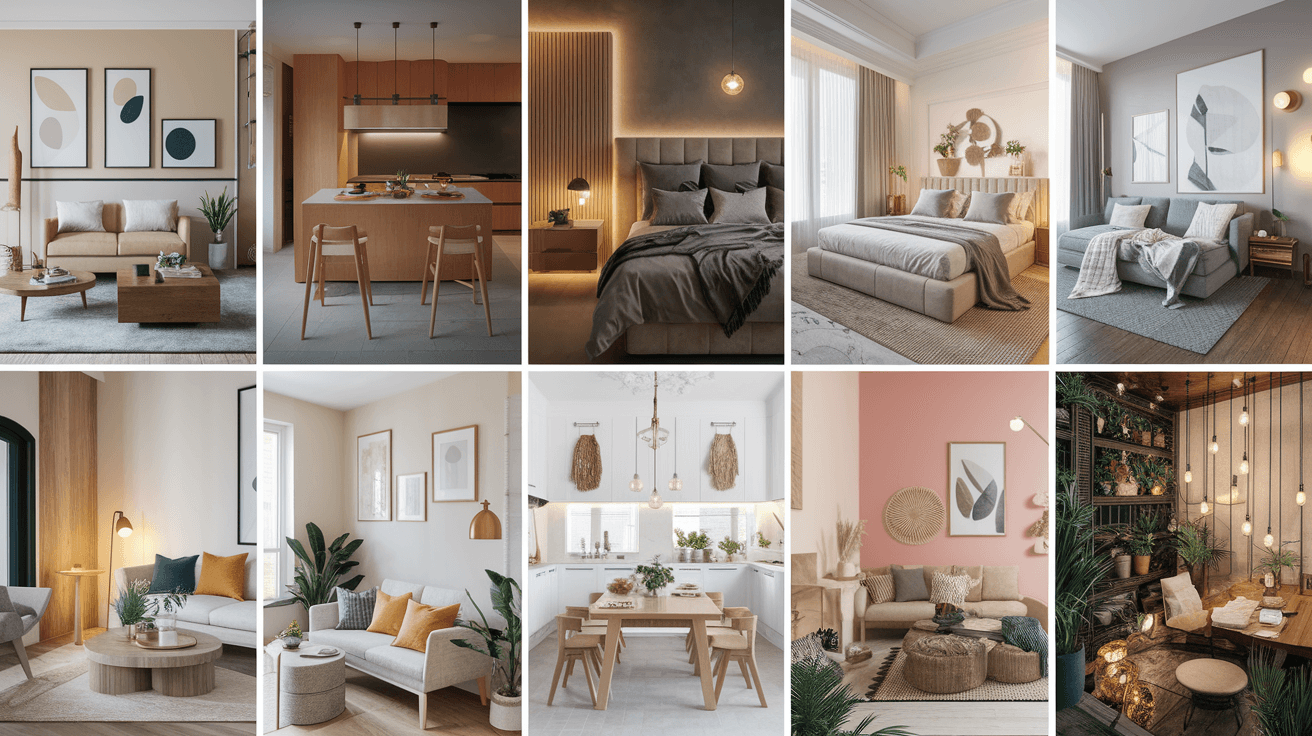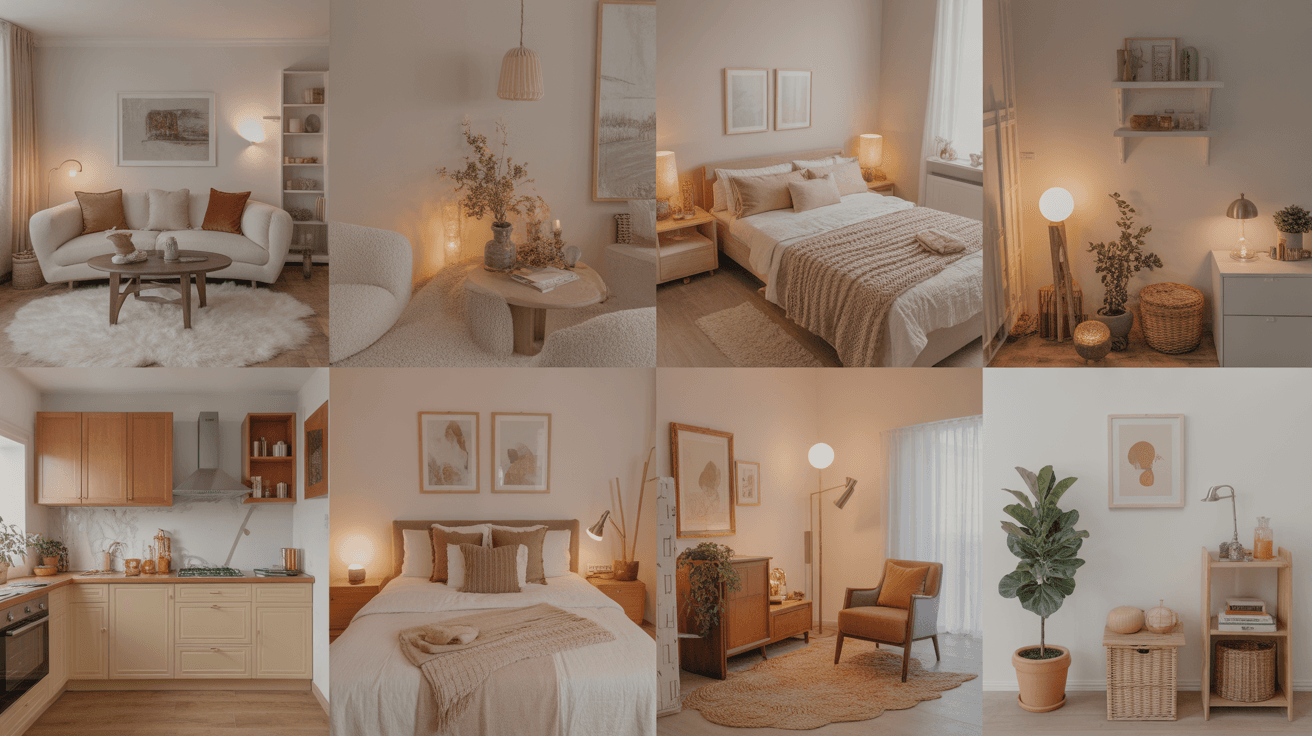24 home daycare setup Ideas
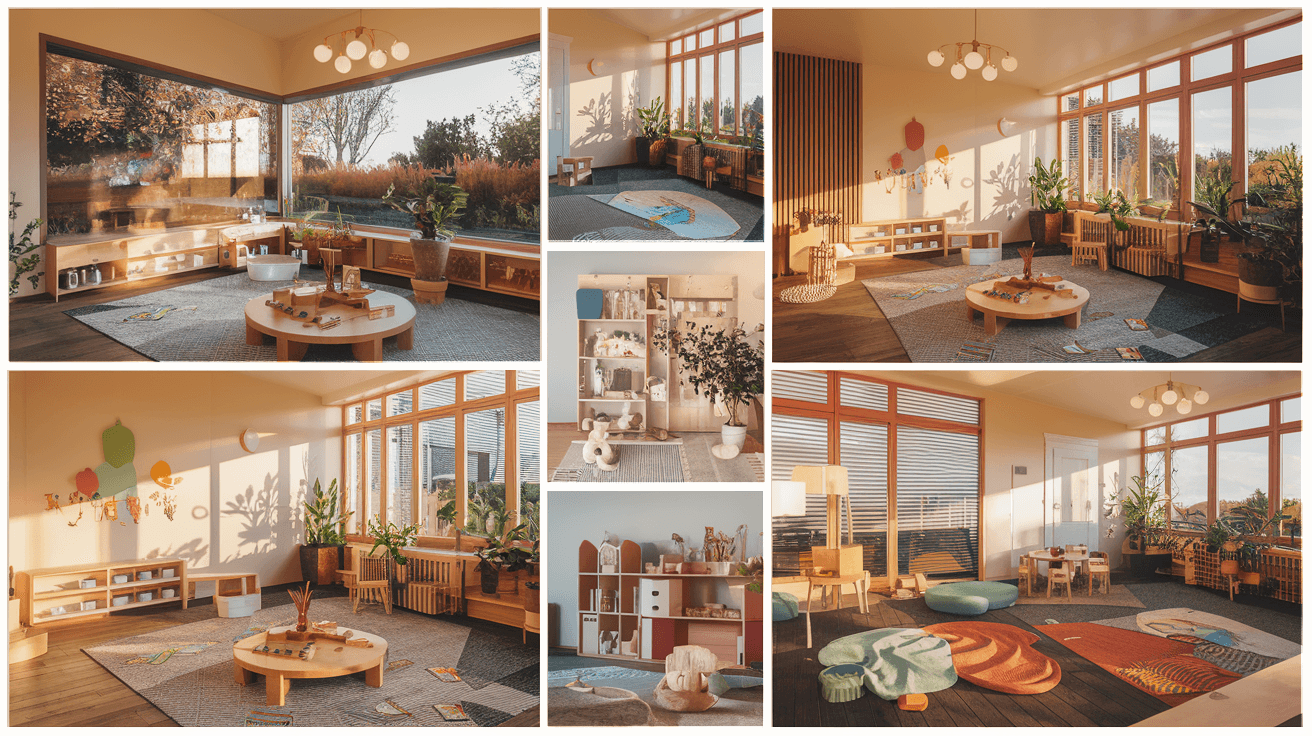
Creating a home daycare setup is about more than just toys and furniture it’s about crafting a nurturing environment that sparks curiosity, comfort, and creativity. Children thrive in spaces that are both engaging and safe, where every corner invites exploration and joy. A well-planned daycare setup allows for structured learning and imaginative play, helping children grow emotionally, socially, and intellectually.
From cozy reading corners to vibrant play areas, each design choice should encourage both freedom and focus. Organization, comfort, and visual stimulation play a crucial role in creating a balanced atmosphere. Below are 24 home daycare setup ideas to help you design a space that feels warm, inspiring, and perfectly suited for little learners.
1. Bright and Cheerful Playroom

A bright playroom sets a happy tone for your daycare. Use soft, lively colors like mint green, sunshine yellow, or sky blue to keep the room vibrant yet calming. Add cozy rugs, wall decals, and open shelves with toys to make the space fun, safe, and easy to explore. Natural light enhances warmth and energy throughout the room.
Divide the area into clear zones a play corner, puzzle table, and reading spot to help kids learn organization and independence. With cheerful details and smart layout, the playroom becomes a lively hub for creativity, joy, and growth.
Best For: Promoting joyful play and independent learning.
Pro Tip: Label storage bins with names to teach responsibility and easy cleanup.
2. Safe Soft-Play Corner

A soft-play corner is the heart of safe, active fun in any daycare. Use padded flooring, foam blocks, and cushioned tunnels to let toddlers crawl and climb freely without worry. The soft textures promote sensory awareness and balance while building motor skills through playful movement. It’s a must for energetic little explorers.
Vary the shapes and levels of soft structures to boost confidence and coordination. You can design simple obstacle paths or foam stairs for a mini adventure zone. This space not only ensures safety but also fosters social interaction, teamwork, and early problem-solving through motion and touch.
Best For: Toddlers exploring physical play safely.
Pro Tip: Pick durable, easy-to-clean foam materials for long-lasting fun.
3. Cozy Reading Nook

A cozy reading nook inspires imagination and calm learning. Decorate with floor pillows, rugs, and low shelves to keep books within reach. Warm lighting and soft hues create a peaceful corner where children can unwind and dive into stories. This quiet setup encourages focus and builds early literacy habits.
Add personality with small touches a hanging canopy, string lights, or story-themed cushions. Let kids choose a “reading buddy” plush toy to accompany them, making reading feel like a comforting adventure. It’s a space that blends relaxation with education, helping nurture empathy and creativity.
Best For: Early readers and quiet reflection.
Pro Tip: Use a small rug or mat to define and anchor the reading space.
4. Creative Art Station

An art station is where imagination blossoms. Set up child-sized tables with crayons, paints, and paper rolls so kids can explore freely. Art encourages creativity, emotional growth, and coordination — vital for early development. Keeping supplies organized and within reach nurtures independence and excitement.
Add a small gallery wall to display their creations, boosting confidence and joy. Rotating artwork keeps the space fresh, while themed crafts like seasonal collages or nature art link fun with learning. A creative corner like this turns simple play into meaningful discovery.
Best For: Boosting creativity and motor skills.
Pro Tip: Keep washable materials and aprons handy for quick cleanup.
5. Nature-Themed Play Area

A nature-themed daycare brings calmness and a touch of the outdoors inside. Use wooden toys, rattan baskets, and earthy tones like green and beige to create a soothing space that encourages focus and relaxation. Natural textures help children feel grounded while keeping the atmosphere warm and welcoming.
Include simple nature-based activities like watering plants, playing with sensory bins of sand or stones, or exploring a small indoor garden. These experiences build curiosity and mindfulness while teaching responsibility. It’s a peaceful, eco-friendly setup that blends learning with natural beauty.
Best For: Calm and eco-inspired daycare environments.
Pro Tip: Choose non-toxic plants and washable natural materials for easy upkeep.
6. Interactive Learning Wall
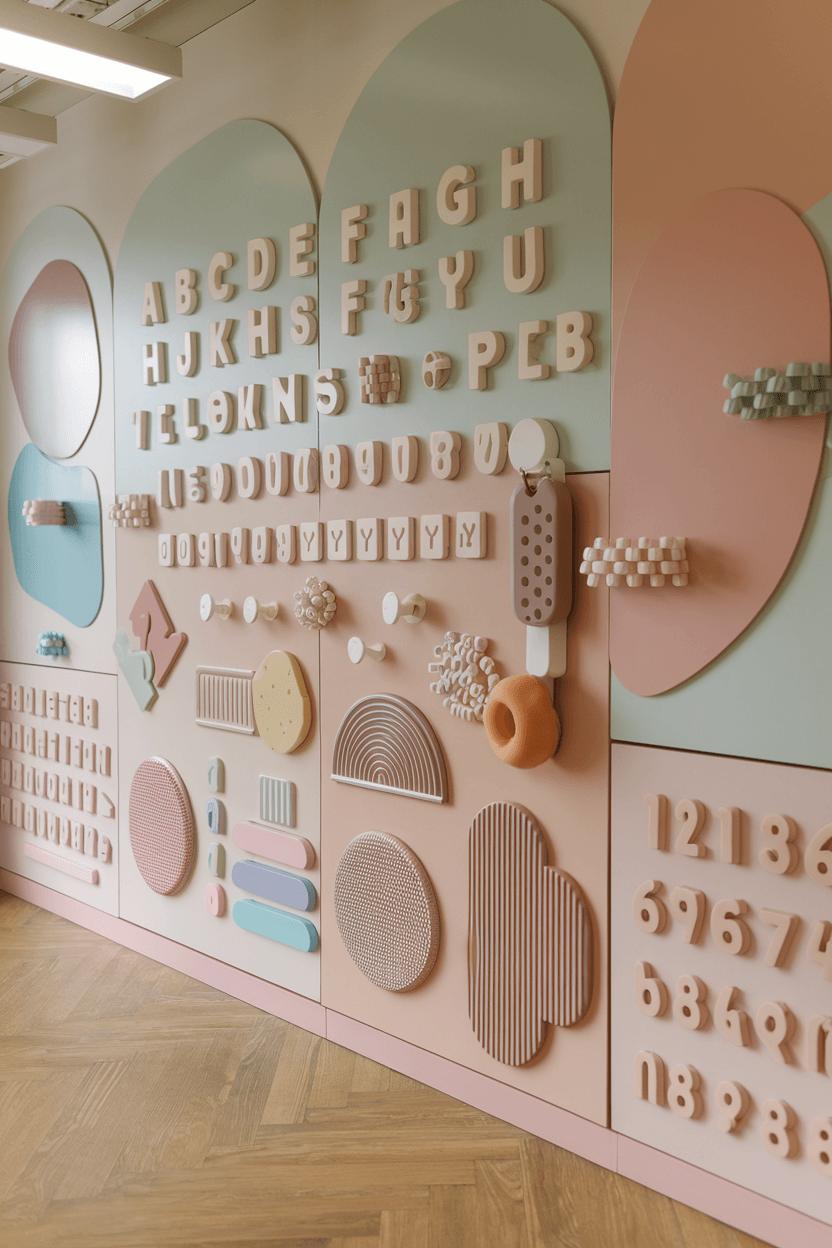
An interactive learning wall transforms blank space into a hands-on education zone. Include alphabet tiles, numbers, textures, and movable shapes that promote tactile learning. This interactive display keeps children engaged while reinforcing cognitive and language skills in a fun, visual way.
Expand the experience by including seasonal themes such as color sorting in spring or shape puzzles in winter. Children can explore, learn, and interact with the wall at their own pace, building confidence and problem-solving abilities. Regularly changing the content also keeps curiosity alive and learning fresh throughout the year.
Best For: Early learners who thrive on sensory play.
Pro Tip: Mount components at eye level for easy reach and active engagement.
7. Organized Storage System
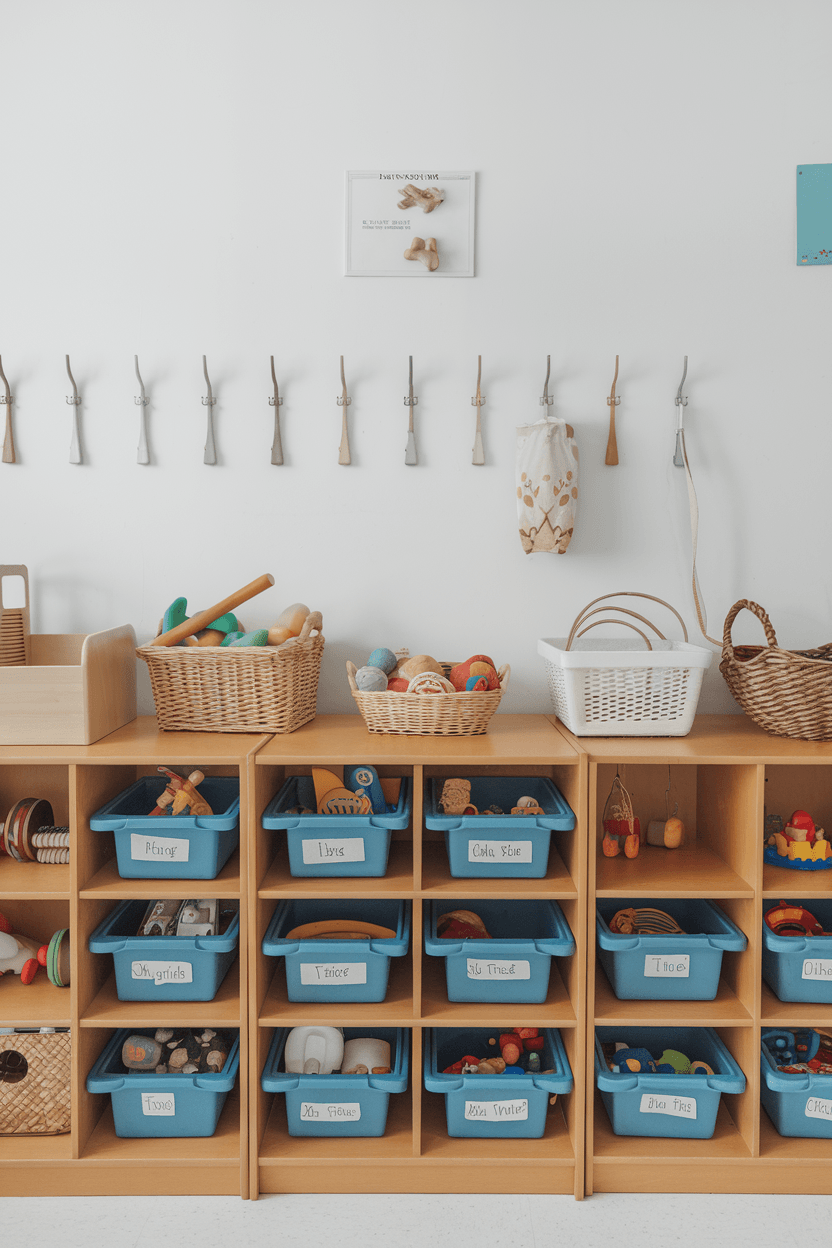
A well-organized storage system creates order and structure within the daycare. Open cubbies, labeled baskets, and see-through bins make it easy for kids to find and return toys independently. Good organization teaches responsibility and helps keep the space safe and visually calm.
To make organization fun, categorize items by color or type like building toys, art materials, or storybooks. Encourage children to participate in cleanup routines, turning it into a group activity that builds teamwork. Over time, they’ll learn to appreciate structure and take pride in maintaining their environment.
Best For: Multi-zone daycares with frequent activity changes.
Pro Tip: Use picture labels for non-readers to help them identify where items belong.
8. Mini Dining Area
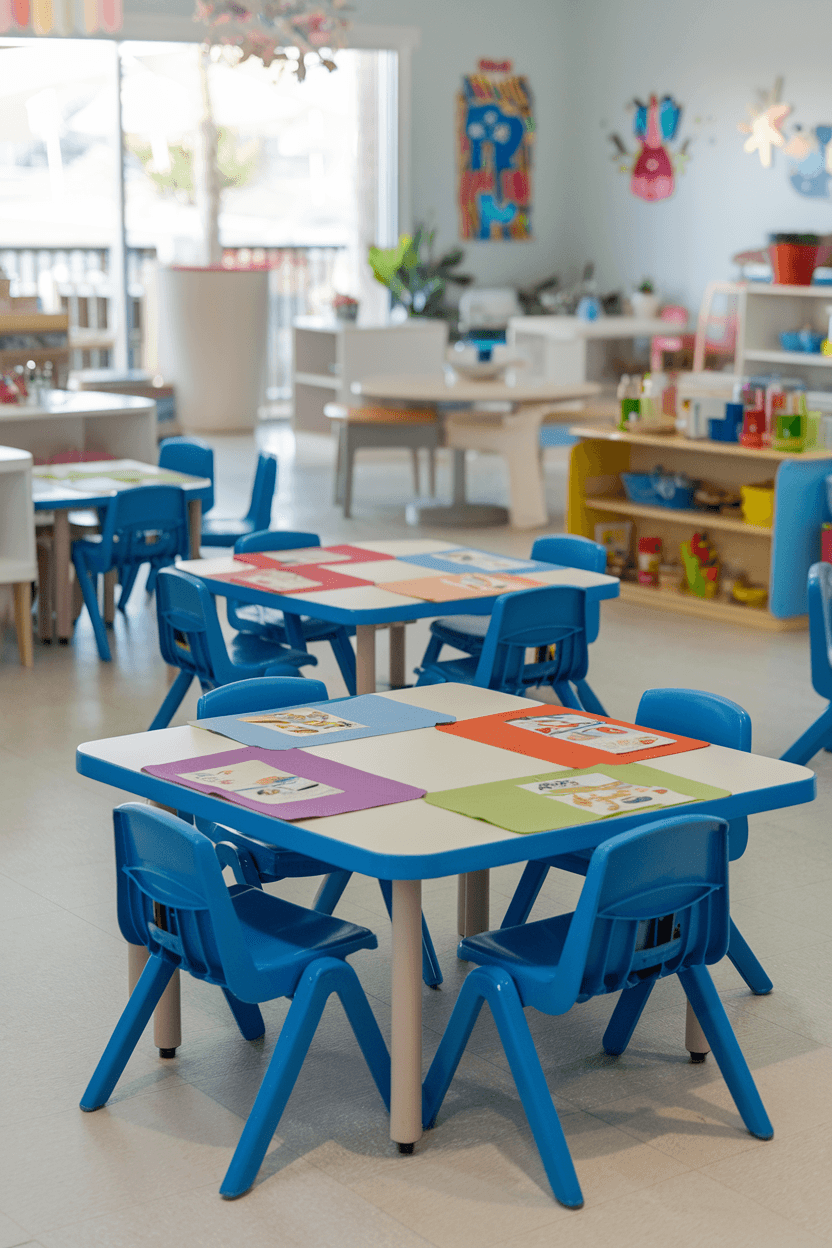
A child-sized dining area teaches social skills and independence during mealtime. Use small tables and chairs that allow kids to sit comfortably and engage with one another. Bright placemats, child-safe utensils, and cheerful wall art make the setting more enjoyable.
Add extra detail with themed days like “color plate day” or “fruit Friday” to make meals fun and educational. Creating a calm, organized dining space helps children develop proper eating habits, good manners, and a sense of community as they share food and conversation with their peers.
Best For: Teaching healthy habits and social behavior.
Pro Tip: Use silicone mats or easy-wipe tablecloths for stress-free cleanup.
9. Nap Zone with Soft Lighting
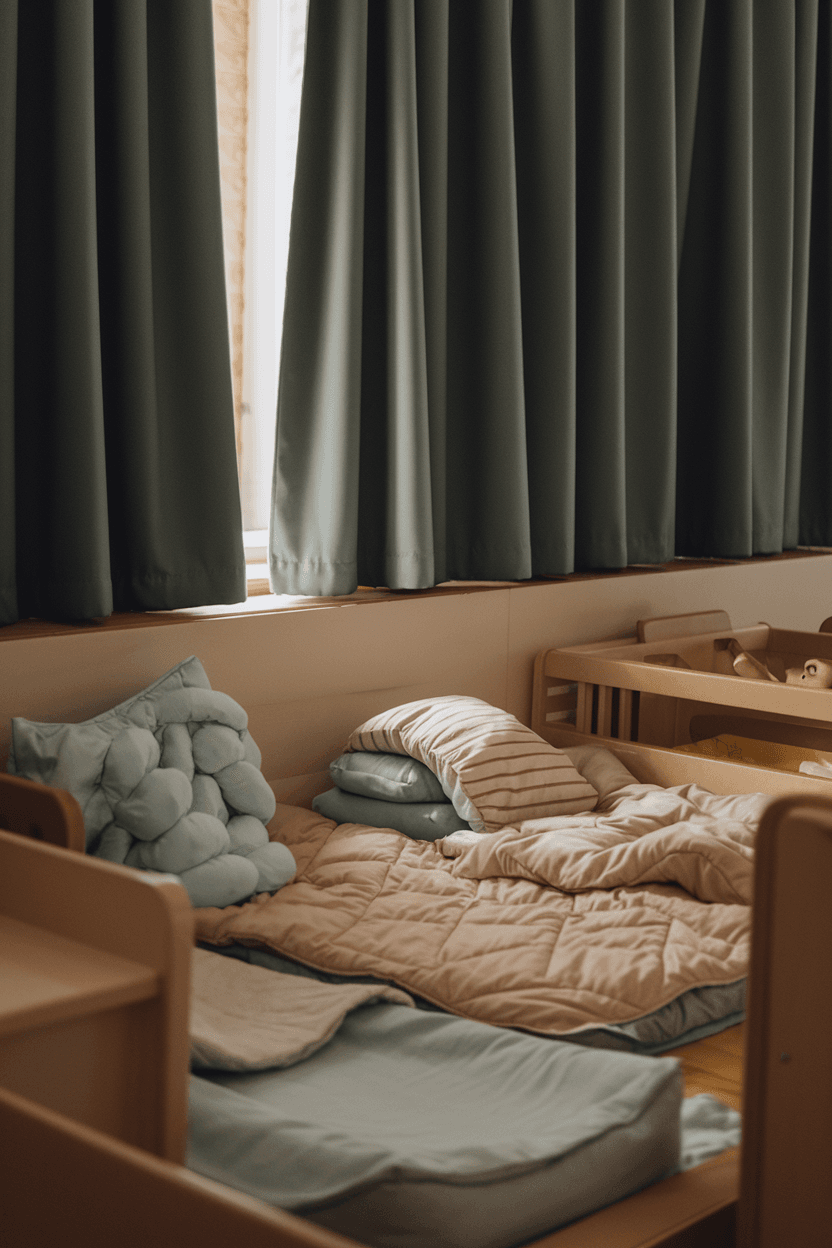
A dedicated nap zone ensures children recharge properly during the day. Use soft bedding, blackout curtains, and dimmable lighting to create a peaceful and secure atmosphere. Gentle background music or nature sounds can help ease kids into relaxation.
To enhance comfort, arrange beds or mats in a pattern that allows personal space while maintaining supervision visibility. Keeping consistent nap routines supports emotional balance, improves focus, and makes transitions smoother throughout the day. A calm rest area also helps children associate sleep with safety and comfort.
Best For: Maintaining healthy routines and rest times.
Pro Tip: Wash and sanitize bedding regularly to maintain hygiene and freshness.
10. Themed Play Zones
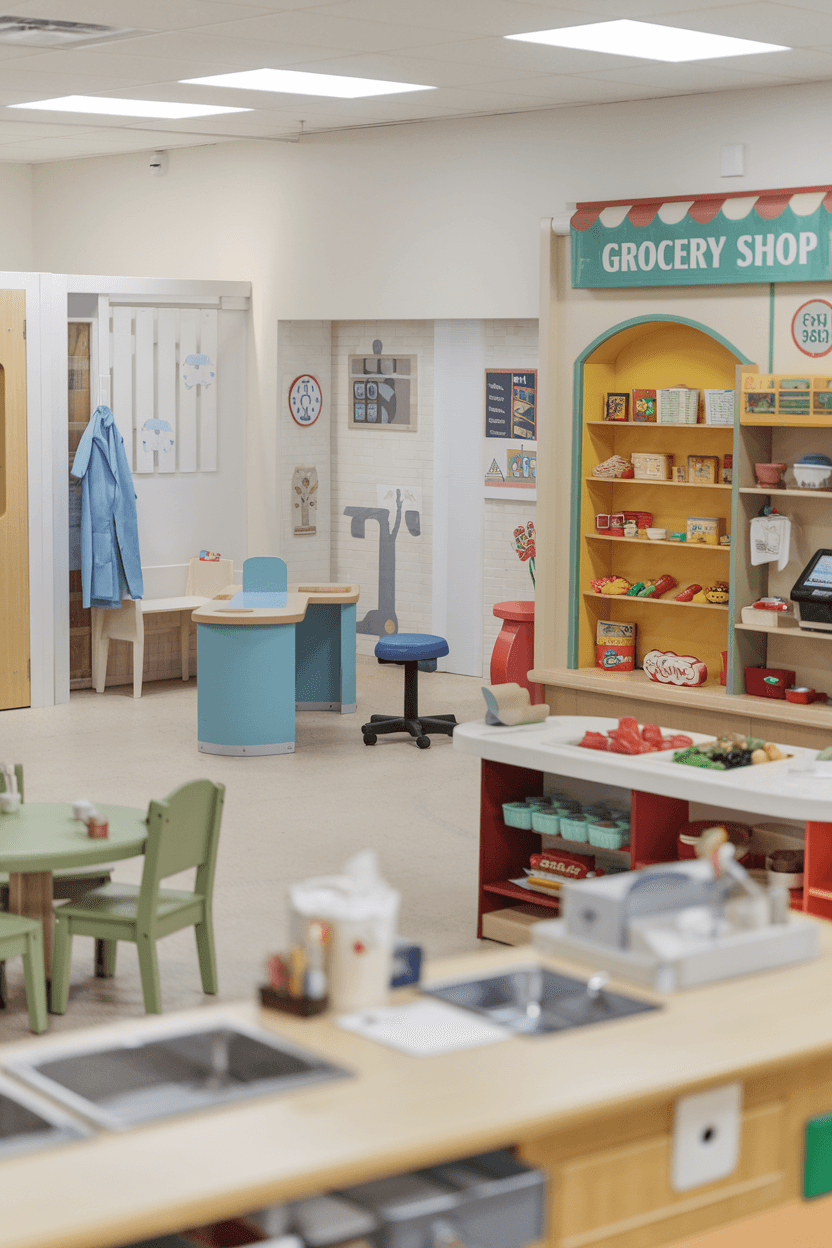
Themed play areas transform learning into immersive experiences. Create small setups like a pretend café, doctor’s office, or grocery store to spark imaginative role play. These themed environments teach cooperation, empathy, and problem-solving while keeping playtime exciting.
You can enhance engagement by updating themes seasonally or tying them to learning goals such as “community helpers” or “around the world.” Rotating props and costumes keeps the space vibrant and encourages storytelling. It’s an easy way to blend fun and education seamlessly while fostering teamwork among children.
Best For: Imaginative play and cognitive growth.
Pro Tip: Keep lightweight props that can be easily swapped or rearranged for new setups.
11. Outdoor Play Space
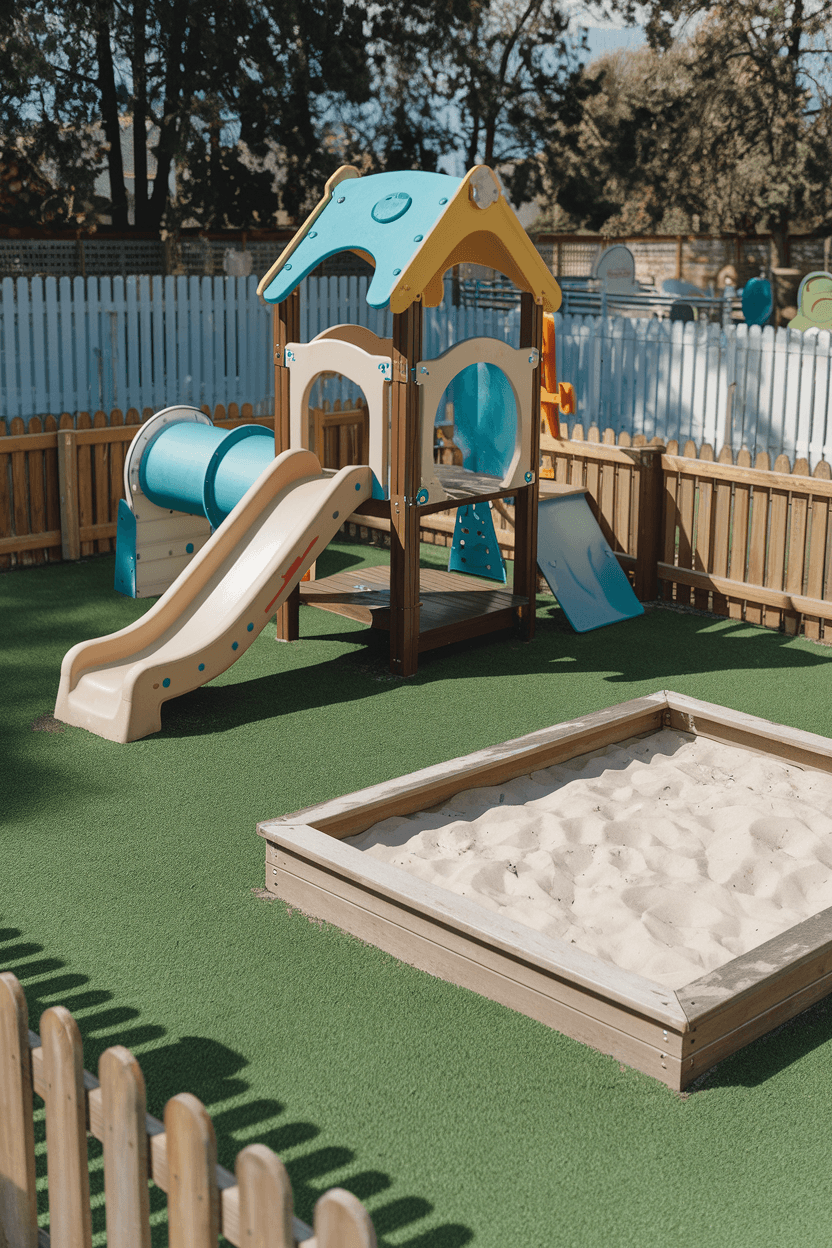
An outdoor play area is a wonderful way to keep kids active and engaged. Fresh air and sunshine help improve their mood, while open space encourages movement and creativity. Add child-safe play gear like slides, tunnels, or sandboxes to make outdoor time both fun and beneficial.
To make it more meaningful, include nature-based play such as gardening or watering plants. These simple activities spark curiosity and teach children about responsibility and care for the environment. Outdoor play also supports balance, teamwork, and healthy development in a joyful way.
Best For: Encouraging physical growth and outdoor learning.
Pro Tip: Use soft turf or rubber mats to create a safe, low-maintenance play zone.
12. Music and Movement Zone
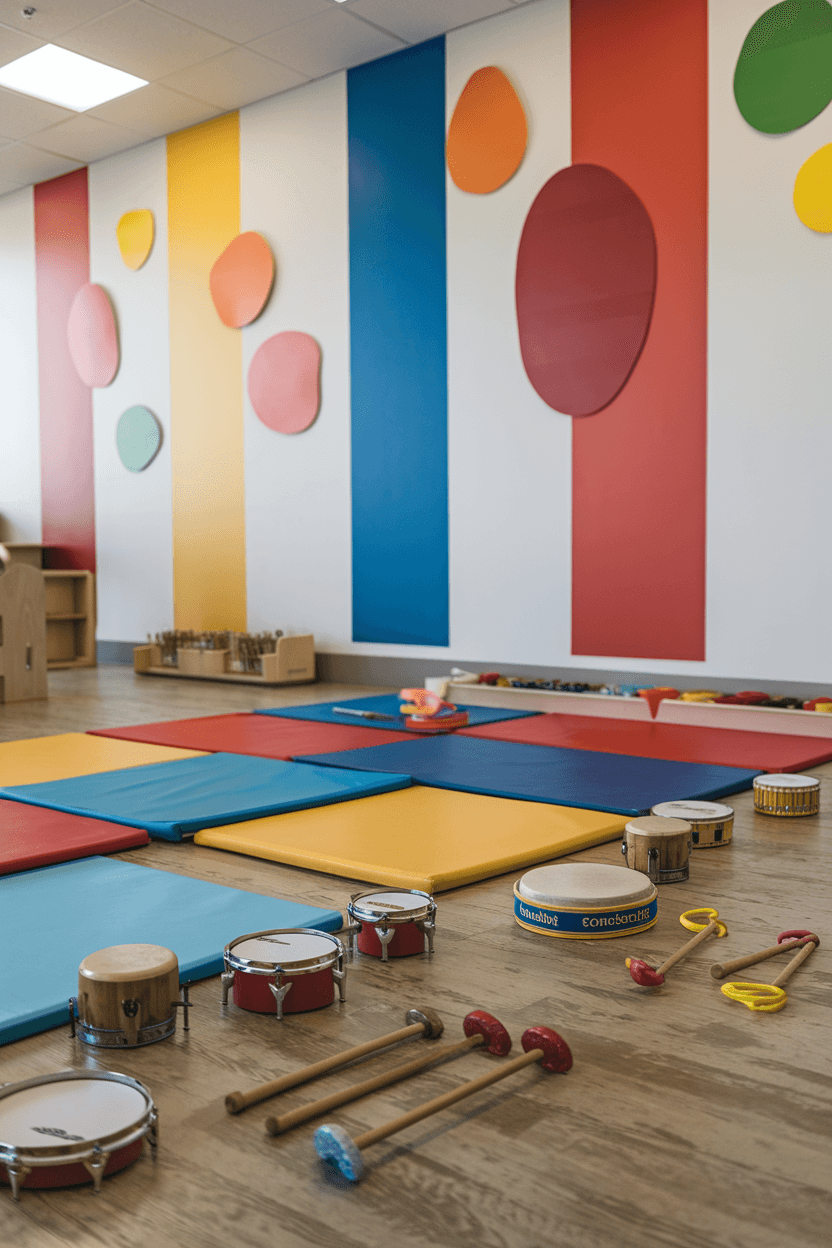
Music is a universal language that children love to explore. A music and movement area helps them express energy, rhythm, and coordination. Include drums, shakers, tambourines, and a Bluetooth speaker to play kid-friendly songs. This setup keeps children active and stimulates auditory development while encouraging creativity.
You can turn this space into a mini stage by adding a soft mat or curtain backdrop for performance time. Plan daily rhythm sessions, dancing games, and sing-alongs to develop listening and timing skills. Musical play improves concentration, balance, and confidence, making it an essential part of a well-rounded daycare.
Best For: Boosting energy, rhythm, and teamwork.
Pro Tip: Rotate musical instruments weekly to keep engagement fresh and exciting.
13. STEM Discovery Corner
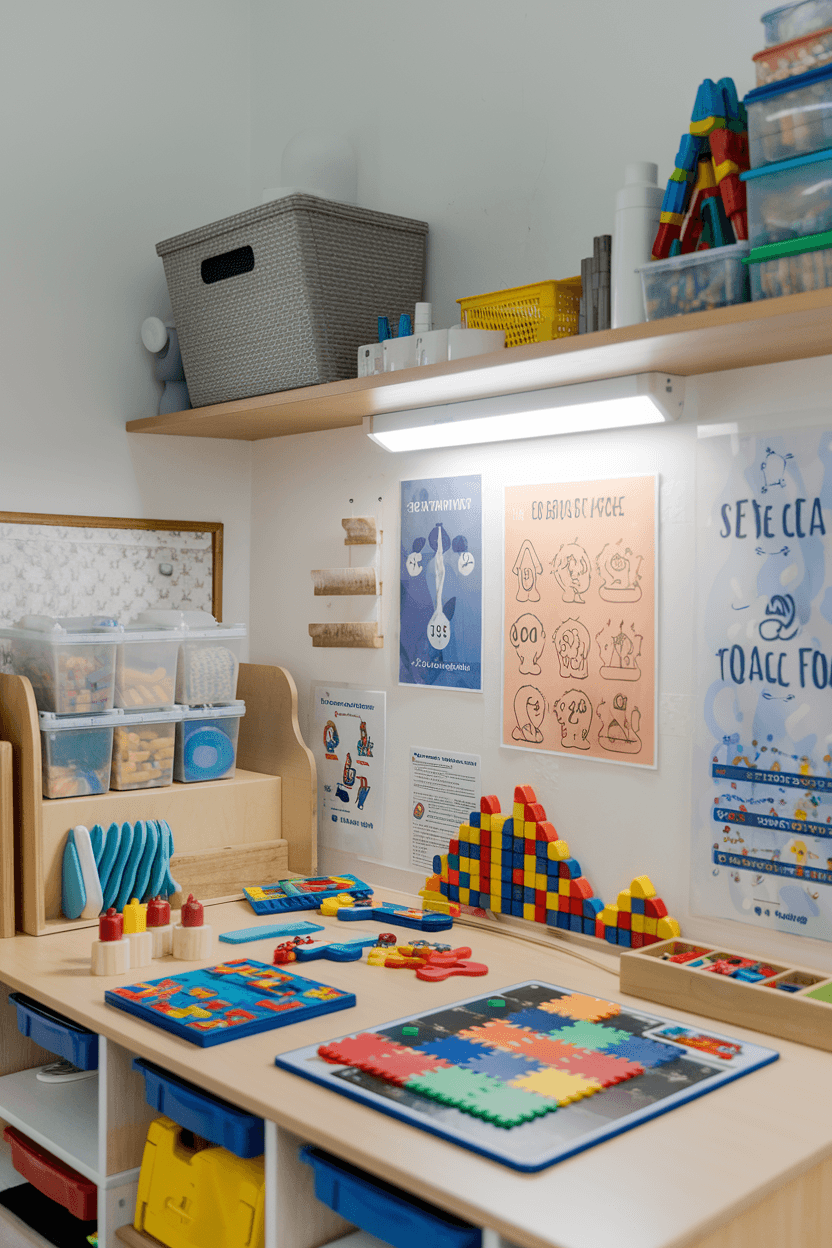
A STEM corner introduces science, technology, engineering, and math concepts in fun, age-appropriate ways. Use puzzles, magnetic tiles, and building blocks to nurture logical thinking. Simple experiments like observing water changes or building paper bridges keep curiosity alive and build problem-solving skills.
Make this area visually inspiring by using educational posters, sensory tools, and labeled containers for materials. Rotate activities regularly so children always find something new to explore. Encouraging them to ask “why” and “how” strengthens their observation skills and helps them understand the world in a playful, hands-on manner.
Best For: Early learning and curiosity building.
Pro Tip: Keep STEM activities short, visual, and interactive to match kids’ attention spans.
14. Mini Classroom Setup
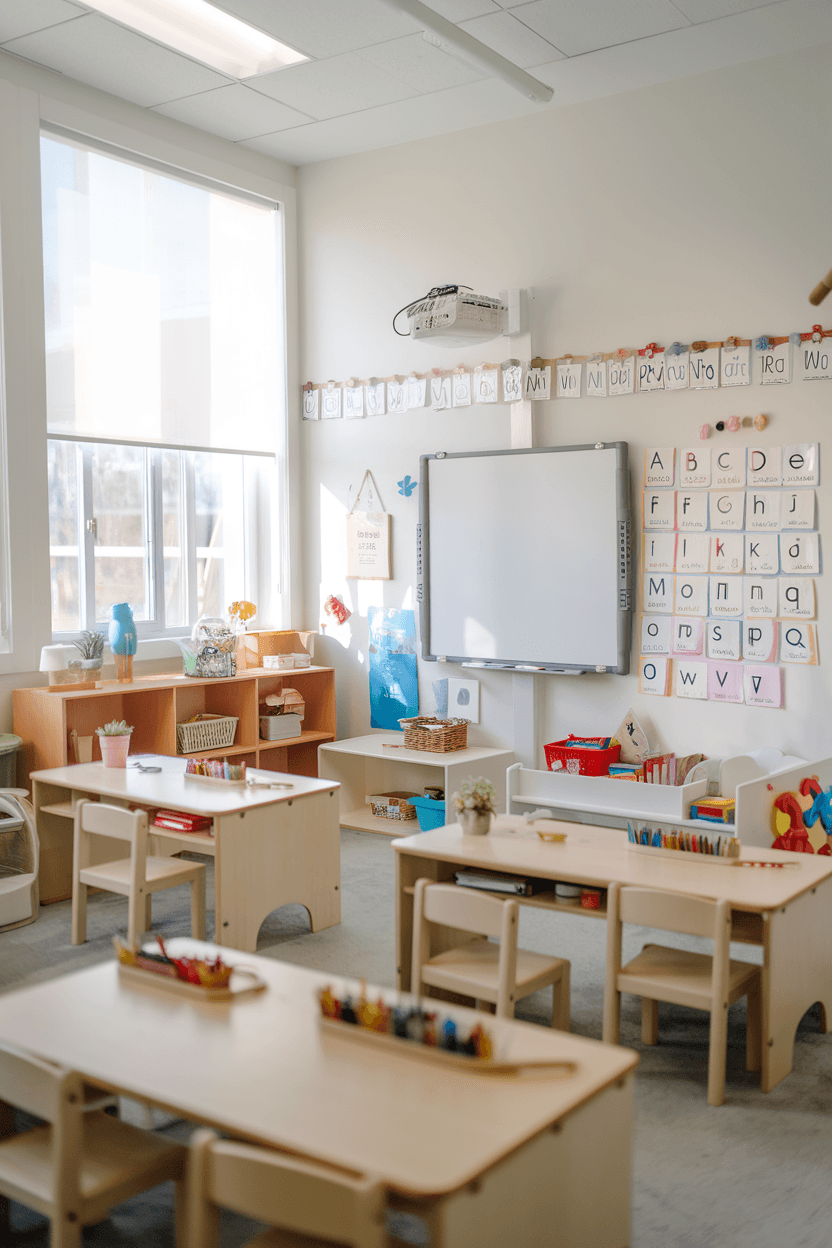
A mini classroom brings structure to the daycare routine, preparing kids for preschool or kindergarten. Small tables, chairs, and a whiteboard or felt board create a professional yet playful learning space. Use bright wall charts for alphabets, colors, and shapes to reinforce lessons visually.
Incorporate short circle time, calendar checks, or weather discussions each morning. This not only builds discipline and routine but also boosts communication and listening skills. A mini classroom blends learning with fun while giving caregivers a chance to track each child’s progress more effectively.
Best For: Structured learning and daily routines.
Pro Tip: Keep lessons short and use songs or visuals to make concepts easy to grasp.
15. Parent Communication Board
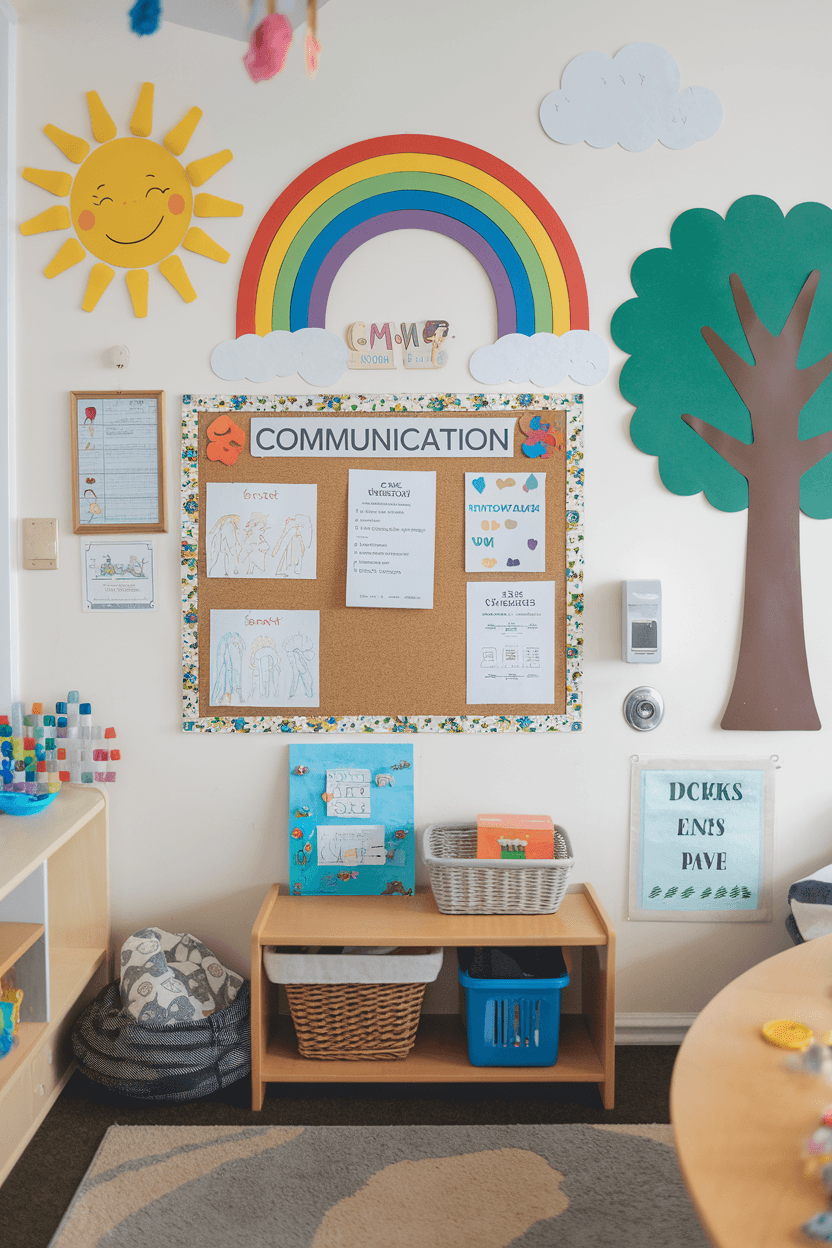
A parent communication board creates a strong bridge between caregivers and families. Use it to display daily activities, snack menus, announcements, and children’s artwork. It helps parents stay informed and engaged with their child’s daycare experience.
Make the board lively with color-coded sections, photos, or handwritten notes from kids. You can even add a “weekly spotlight” section to highlight children’s achievements. Transparent communication builds trust, strengthens relationships, and ensures parents feel connected and reassured about their child’s care.
Best For: Building transparency and trust with parents.
Pro Tip: Update the board daily to maintain excitement and communication consistency.
16. Infant Care Zone
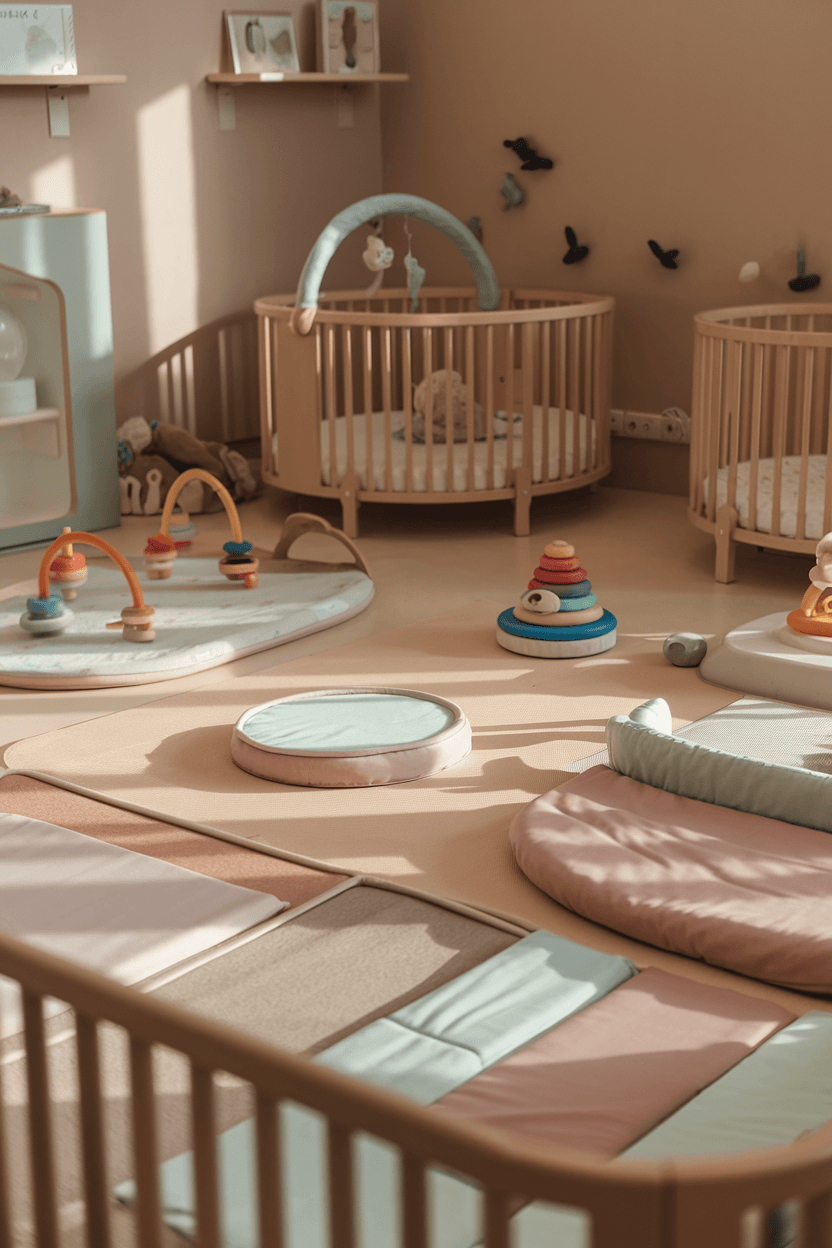
Infants need a dedicated area designed with safety, comfort, and nurturing in mind. Include soft mats, baby cribs, and age-appropriate sensory toys to keep them engaged. Gentle lighting and pastel tones create a calming atmosphere that supports restful naps and happy playtime.
To make it functional, ensure easy access to diaper stations, sanitizers, and storage for baby essentials. Keep the space clutter-free but stimulating with soft mobiles or textured toys. A cozy, well-managed infant zone allows caregivers to provide personalized attention while ensuring infants feel secure and loved.
Best For: Babies aged 0–2 needing a nurturing environment.
Pro Tip: Sanitize surfaces multiple times a day to maintain hygiene and safety.
17. Sensory Exploration Table
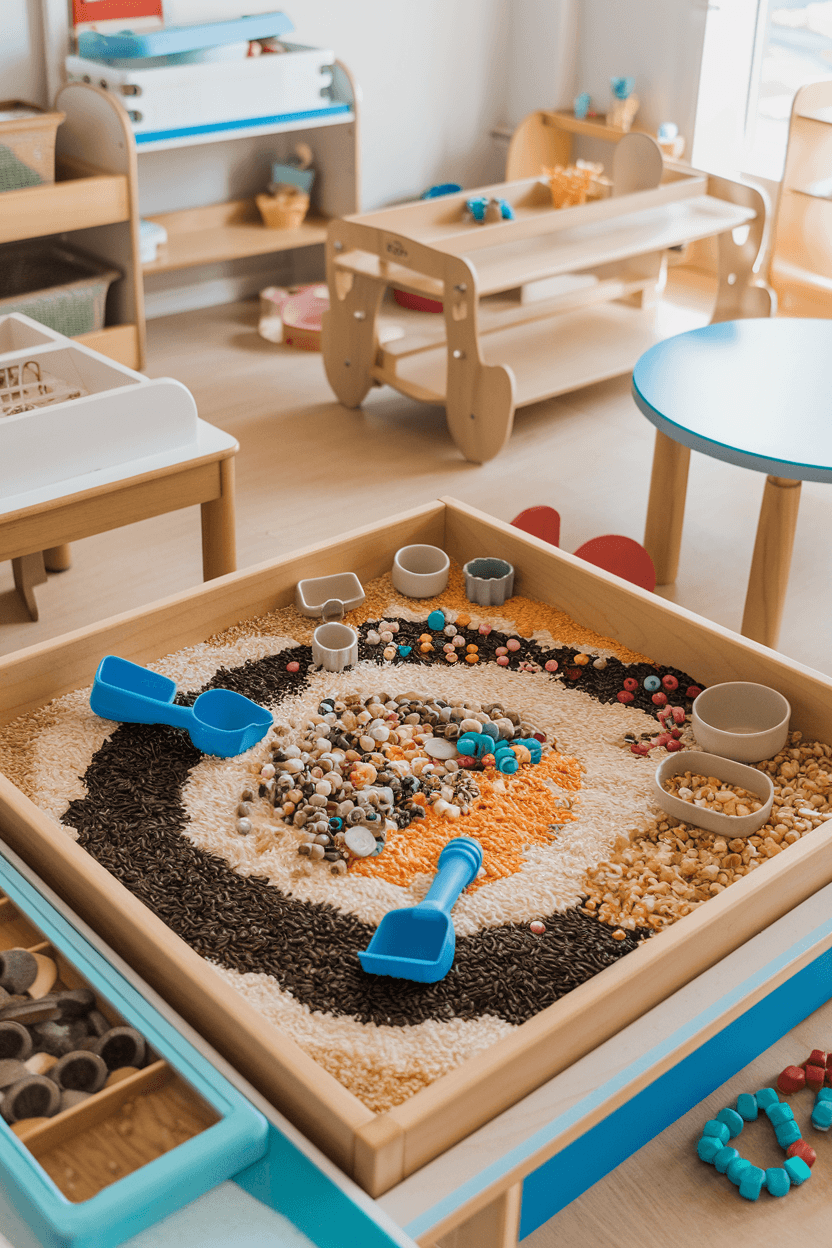
A sensory table offers endless opportunities for hands-on learning. Fill it with materials like rice, water beads, kinetic sand, or natural items like leaves and stones. Sensory play helps children develop cognitive and fine motor skills while enhancing focus and creativity.
To expand the experience, change the themes weekly like ocean life, seasons, or colors. Add tools such as scoops, funnels, and magnifying glasses for extra engagement. Sensory exploration is not only educational but also soothing for children who need tactile stimulation to process their surroundings.
Best For: Boosting focus, calmness, and tactile learning.
Pro Tip: Supervise closely and use edible or non-toxic materials for safety.
18. Multi-Activity Room
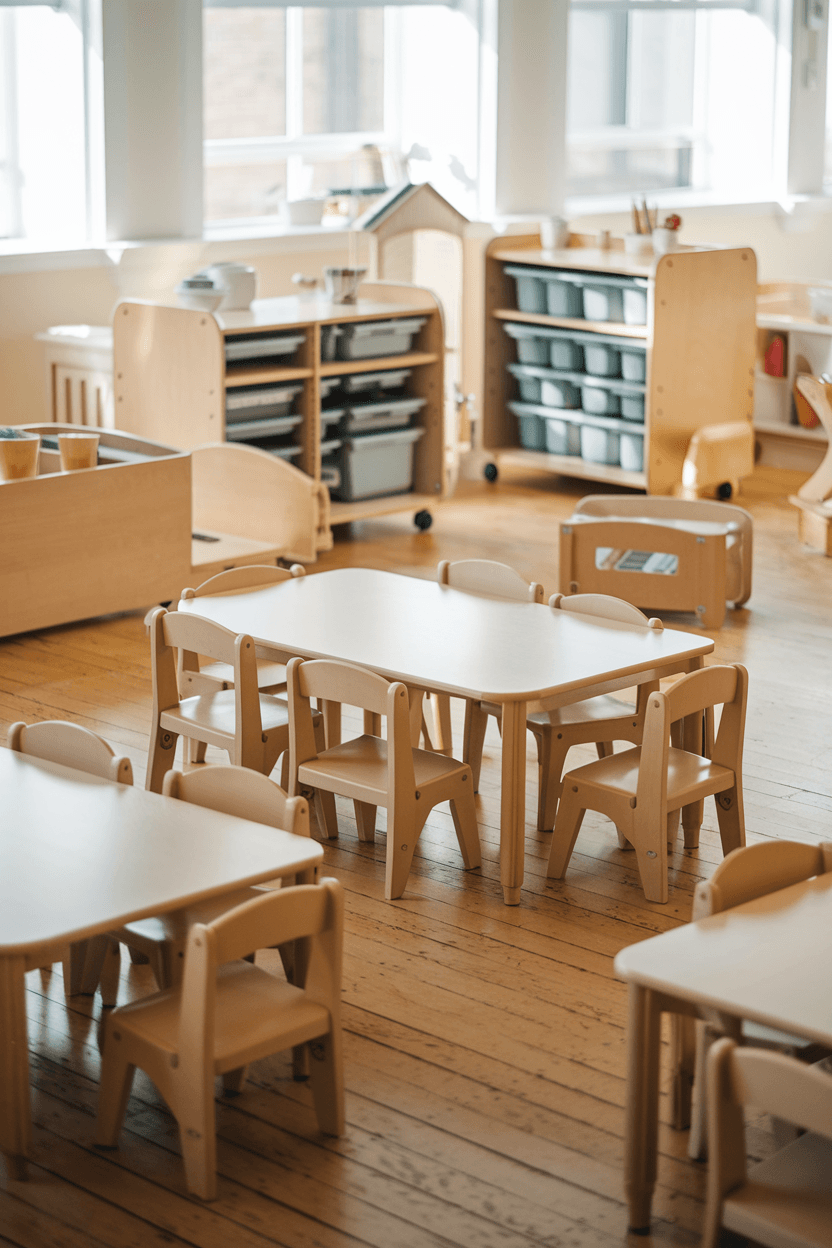
A multi-activity space keeps the daycare flexible and dynamic. This room can transform from a play zone to a craft workshop or nap area with simple furniture rearrangements. Use foldable tables, stackable chairs, and lightweight dividers to change setups quickly.
Adding movable storage carts and portable art racks allows smooth transitions between activities. A multi-use space helps you manage time efficiently while catering to different age groups and interests. It’s a smart way to make the most of limited space without compromising creativity or structure.
Best For: Small daycares needing flexible layouts.
Pro Tip: Use labeled storage to make switching between activities smooth and quick.
19. Entryway with Storage Cubbies
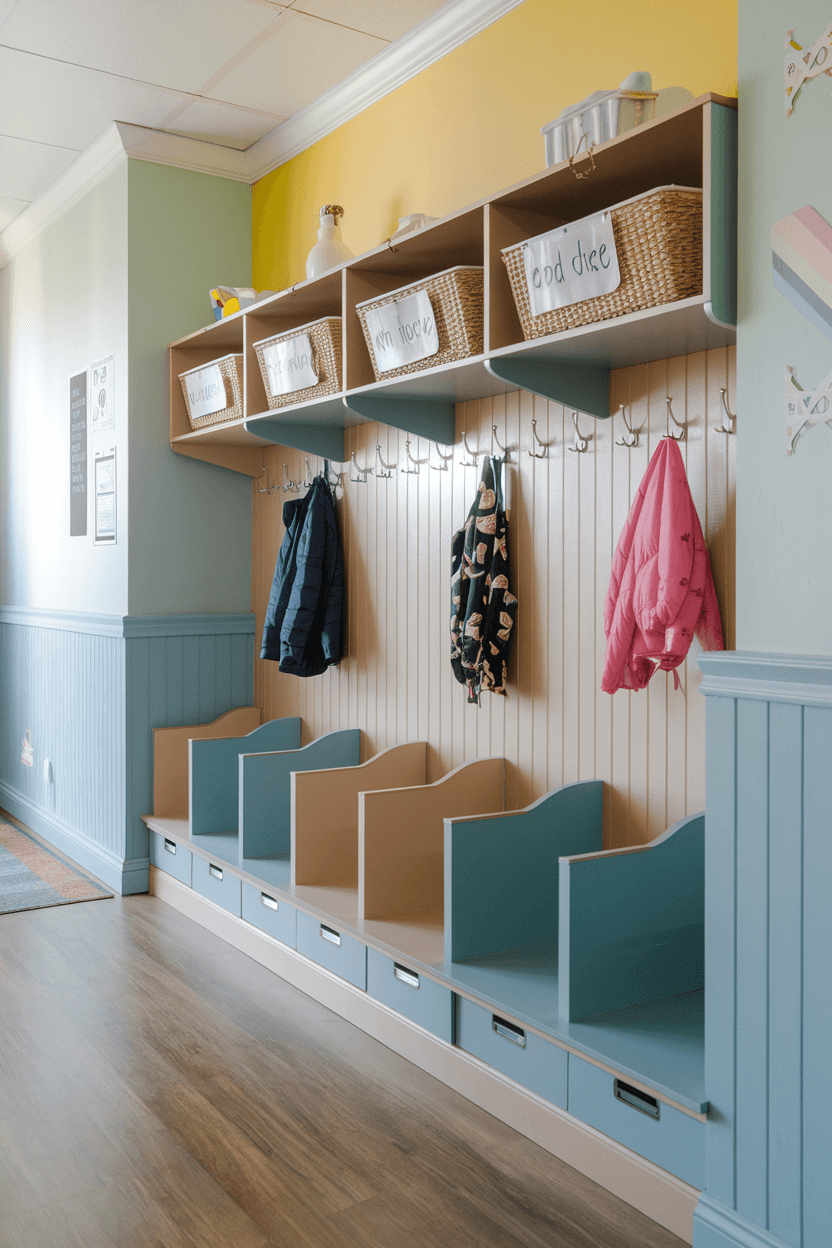
A neat and welcoming entryway sets the tone for your home daycare. Adding labeled cubbies or hooks gives each child a personal spot for their belongings, keeping the area tidy and organized. This simple setup helps kids learn responsibility while making daily routines smoother for parents.
Bright lighting, cheerful colors, and a small bench can make the space both functional and inviting. You can also include a parent notice board or name tags for each child to add a personal touch. A thoughtfully arranged entryway reflects care, organization, and professionalism that parents immediately notice and appreciate.
Best For: Keeping arrivals organized and stress-free.
Pro Tip: Use easy-to-clean bins and surfaces for quick maintenance.
20. Indoor Mini Gym
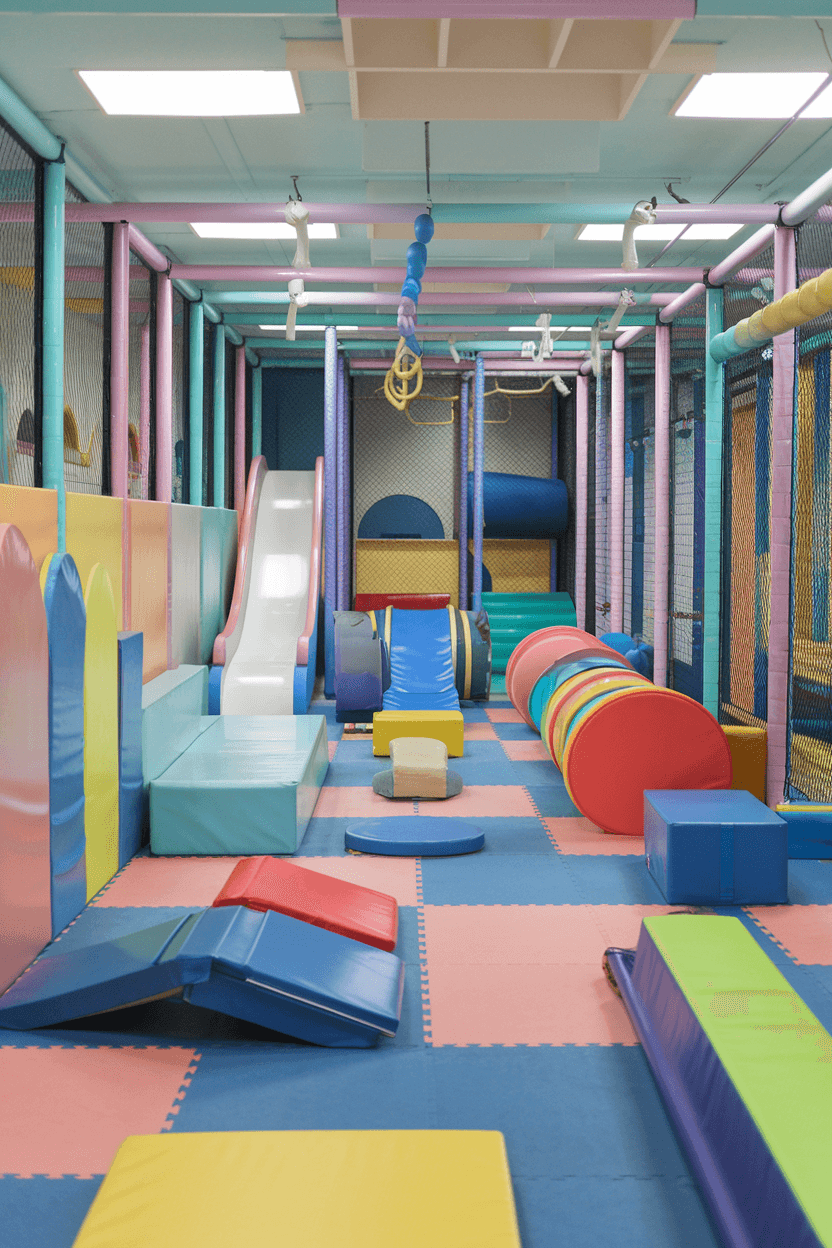
An indoor mini gym keeps children active and healthy, even when outdoor play isn’t possible. Soft play mats, tunnels, mini slides, and balance beams provide endless fun while developing coordination and strength. This space encourages kids to release energy constructively, helping them stay focused during calmer activities later in the day.
To make it more engaging, design small obstacle courses, group games, or yoga sessions for kids. Rotating activities keeps the space exciting and ensures every child finds something they enjoy. A safe indoor gym also allows caregivers to manage active play in a controlled environment while promoting fitness and teamwork.
Best For: Boosting physical activity and motor skills.
Pro Tip: Use foam flooring and padded corners to create a safe, worry-free zone.
21. Calm Down Zone
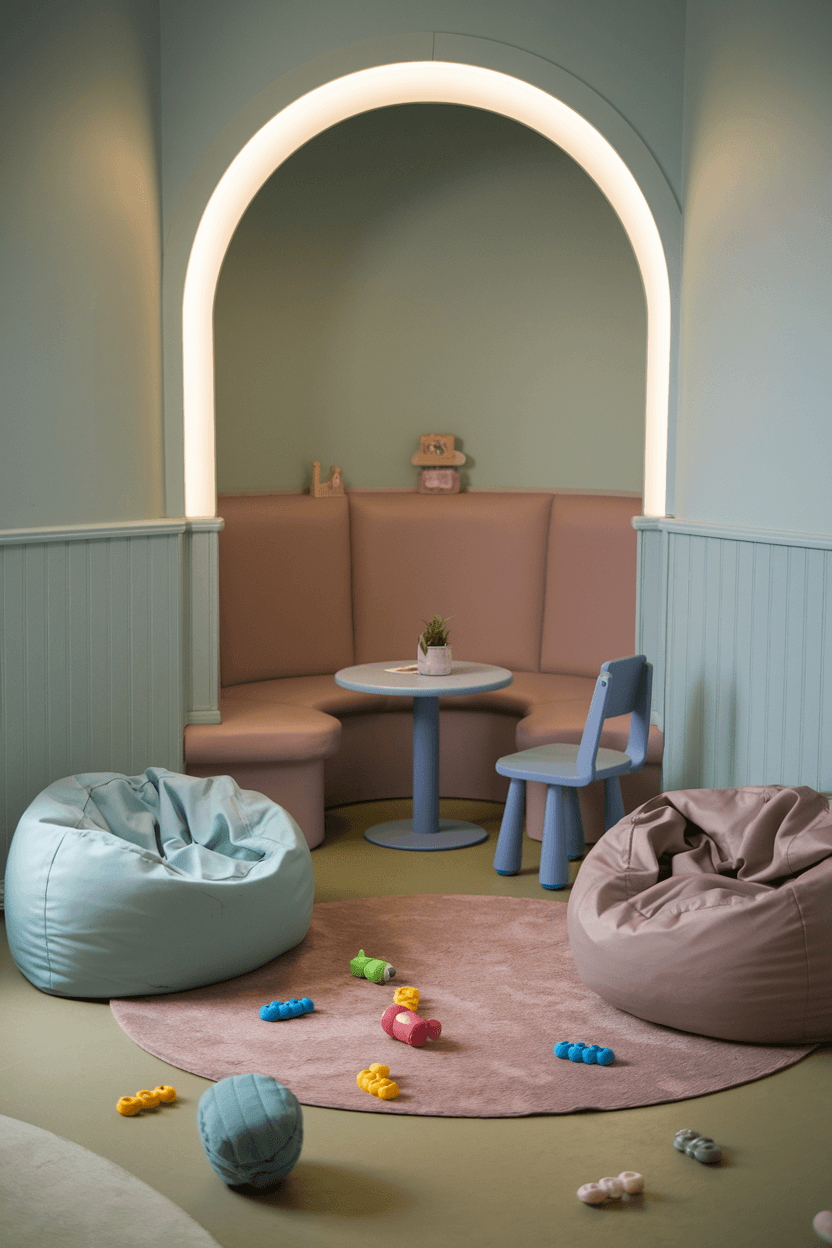
Every daycare needs a peaceful corner where children can take a break from noise and activity. The calm zone helps kids manage emotions and regain focus in a soothing atmosphere. Use soft lighting, bean bags, cozy rugs, and muted colors to create a sense of calm. This space encourages self-regulation, helping children recognize when they need a quiet moment.
Make it even more nurturing with mindfulness tools like fidget toys, breathing jars, or storybooks that promote emotional balance. Playing gentle background music or nature sounds adds a therapeutic touch. A well-designed calm zone teaches kids emotional awareness while offering caregivers a helpful tool for managing group harmony.
Best For: Emotional regulation and mental relaxation.
Pro Tip: Keep the area semi-private but always visible for supervision and safety.
22. Art Display Wall
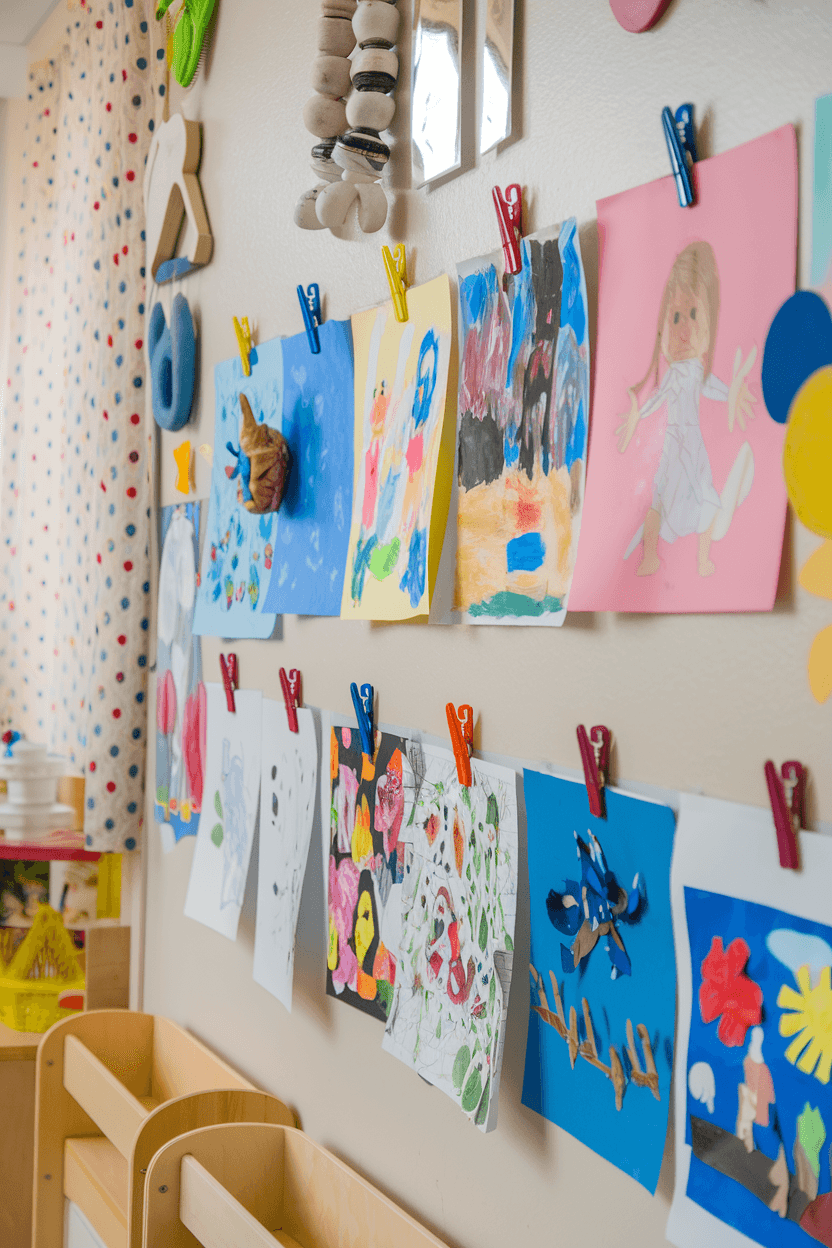
An art display wall celebrates creativity and builds confidence in children. Dedicate a bright section of your daycare to showcase kids’ artwork, crafts, and seasonal projects. It gives children a sense of pride and ownership while motivating them to express themselves freely. Parents also enjoy seeing their child’s work displayed beautifully.
To make it dynamic, use corkboards, clip strings, or magnetic walls so artwork can be changed easily. Add colorful frames or themed backgrounds to match each month’s activities. The art wall becomes a storytelling canvas that encourages imagination and helps children feel valued for their unique efforts.
Best For: Boosting confidence and celebrating creativity.
Pro Tip: Rotate artwork weekly to keep the display fresh and engaging.
23. Snack Preparation Corner

A snack corner encourages independence and healthy habits in young children. Create a child-height counter stocked with bowls, napkins, and nutritious snacks like fruits or crackers. Letting kids help themselves safely teaches responsibility, coordination, and hygiene awareness while turning snack time into a mini learning experience.
Enhance the space by introducing themed snack days or short nutrition lessons. Kids can explore food groups, colors, and counting through their snacks, combining fun and education. A well-planned snack corner adds structure to the daycare day, creating a balance between self-service and guided learning.
Best For: Promoting healthy eating and self-reliance.
Pro Tip: Use washable, child-safe dishes and color-coded trays to prevent mix-ups.
24. Themed Wall Murals

Wall murals instantly transform your daycare into a world of imagination. Choose themes like outer space, jungle animals, or underwater adventures to stimulate curiosity and storytelling. Murals add color, depth, and character to the room, making it feel vibrant and welcoming for children of all ages.
Pair murals with matching play corners — for instance, a tree mural beside a reading nook or a sea wall near a water-play station. These visuals inspire creativity and make learning more interactive. A thoughtfully designed mural not only enhances decor but also helps shape your daycare’s identity and charm.
Best For: Inspiring creativity and imaginative play.
Pro Tip: Use washable, non-toxic paints and large, simple illustrations for the best visual impact.
Final Thoughts
Creating a home daycare setup that blends comfort, creativity, and learning is an art in itself. Every area, from the calm zone to the play corner, should reflect care, warmth, and purpose. By designing spaces that encourage exploration and emotional growth, you build an environment where children thrive happily every day.
The best home daycares grow and adapt with new ideas and the changing needs of children. By focusing on safety, organization, and creativity, you can create a space where every child feels secure and inspired. With care and thoughtful design, your daycare becomes a joyful and trusted place for young learners.
Discover more inspiring daycare decor and design ideas at Trendy Decor Guide your go-to destination for creating functional, stylish, and nurturing spaces for children!

